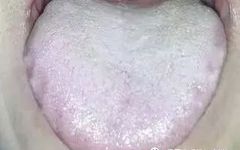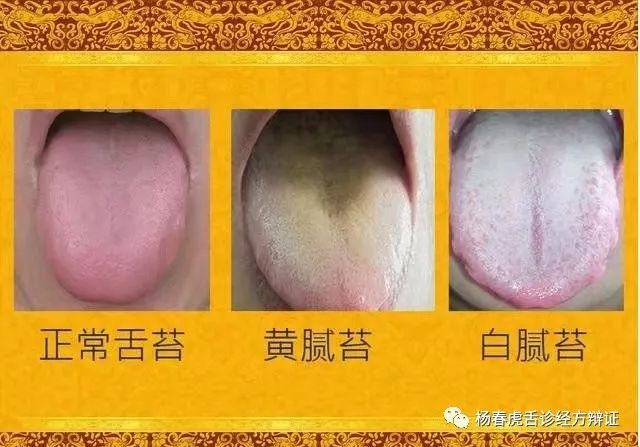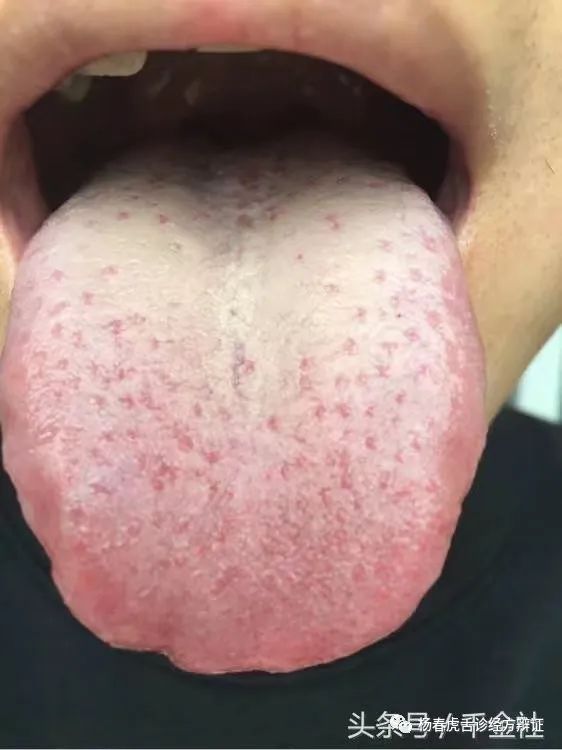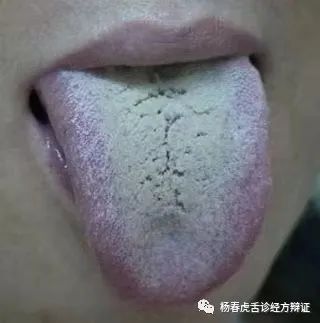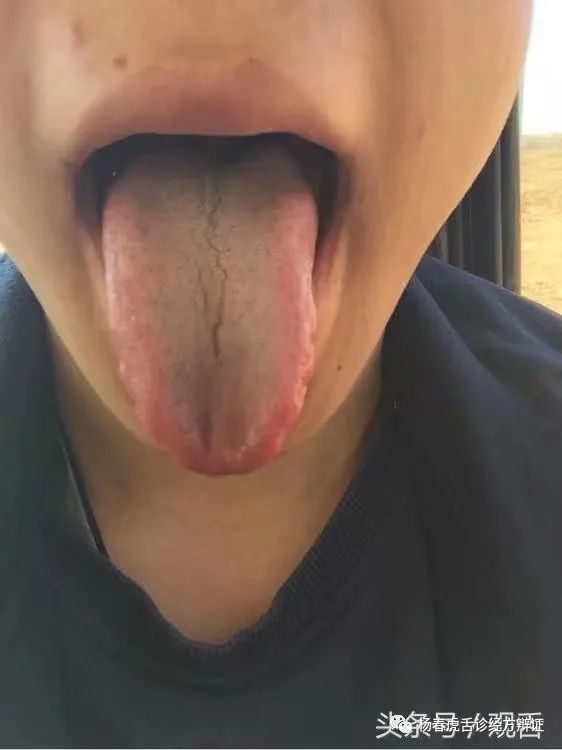Normal tongue coating: pale red tongue with thin white coating.
The tongue coating during a cold is also white, but slightly whiter than normal. Cold-dampness due to internal injury also presents with a white coating, but the white coating from internal injury is thicker.
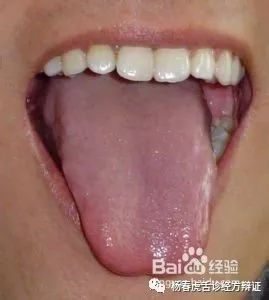 The following images show the tongue coating during a cold, which has turned white.
The following images show the tongue coating during a cold, which has turned white.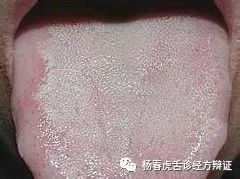 Let’s look at cold-dampness; cold-dampness syndrome is one of the mildest conditions. Observe the tongue coating below. It appears very cold.
Let’s look at cold-dampness; cold-dampness syndrome is one of the mildest conditions. Observe the tongue coating below. It appears very cold.
Notice that this tongue coating shows a strong cold nature. The coating is not yellow, and the medication is also simple. Use Li Zhong Tang (Regulate the Middle Decoction) or Ling Gui Zhu Gan Tang (Poria, Cinnamon, Atractylodes, and Licorice Decoction), with a heavy dose of Gan Jiang (Dried Ginger). This type of patient typically has a deficiency of spleen and stomach cold or has long-term consumption of cold drinks leading to spleen and stomach cold deficiency.
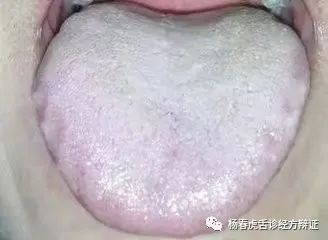 Thick white coating indicates cold-dampness, undoubtedly Bai Zhu (Atractylodes), Hou Po (Magnolia Bark), Chen Pi (Dried Tangerine Peel), and Gan Jiang (Dried Ginger).
Thick white coating indicates cold-dampness, undoubtedly Bai Zhu (Atractylodes), Hou Po (Magnolia Bark), Chen Pi (Dried Tangerine Peel), and Gan Jiang (Dried Ginger).
White greasy coating indicates heavy internal cold. A typical Gan Jiang (Dried Ginger) tongue. Core medication includes Gan Jiang (Dried Ginger) and Huang Ni (Yellow Greasy Coating). For cold transforming into heat, use medications that are both warming and clear heat. Warming can be achieved with Ban Xia (Pinellia) and Sheng Jiang (Fresh Ginger), while heat can be treated with Zhu Ru (Bamboo Shavings) and Zhi Ke (Bitter Orange).
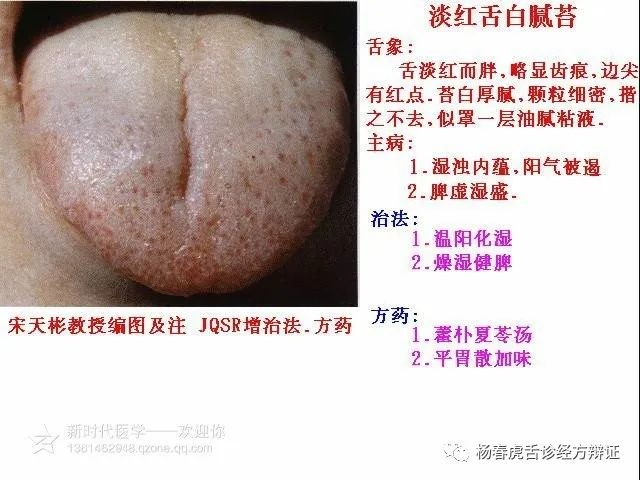
This tongue coating shows changes; the tongue also has red spots. This indicates that it is no longer cold-dampness. The tongue is too thick, and Yang Qi is trapped, unable to disperse, leading to rebellious fire, which can cause canker sores. This is stagnant fire that needs to warm Yang and disperse stagnation, using Gan Jiang (Dried Ginger), Gui Zhi (Cinnamon Twig), to disperse stagnant fire, Fang Feng (Siler), and Bo He (Peppermint).
Red tongue with white coating indicates Ban Xia Xie Xin Tang (Pinellia Decoction) with red spots on the tip; Huang Lian (Coptis) can be used.
Typical phlegm-dampness: Wen Dan Tang (Warm the Gallbladder Decoction) plus Huang Lian (Coptis).
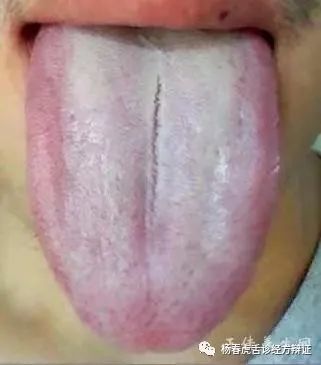 The tongue coating is white in the middle, with cracks indicating cold-dampness and Qi stagnation. The edges are red, indicating liver Qi stagnation transforming into fire, with liver heat and spleen-stomach cold-dampness.
The tongue coating is white in the middle, with cracks indicating cold-dampness and Qi stagnation. The edges are red, indicating liver Qi stagnation transforming into fire, with liver heat and spleen-stomach cold-dampness.
Chicken heart tongue can indicate liver and kidney deficiency. The cracks in the middle can indicate Qi stagnation. Thick coating indicates phlegm-dampness and liver-spleen disharmony. Use Si Ni Tang (Frigid Extremities Decoction) to warm the interior.
In the “Shang Han Lun” (Treatise on Cold Damage), it is written: “A slightly white slippery tongue coating indicates that cold evil has just entered the Tai Yang channel; a thick white slippery tongue coating indicates symptoms of headache and fever, with a floating and tight pulse, and self-recovery through exterior resolution.” This means that a slightly white coating indicates the initial stage of exterior symptoms, where the Tai Yang channel governs the exterior, so this is an exterior symptom. At this stage, the coating is thin and white, indicating increased moisture, and it is a slippery coating, not dry, because it is a cold syndrome. “A white coating with a red tongue indicates that the Tai Yang channel has begun to transmit.” This means that the coating is white, but the tongue body is red, indicating that the Tai Yang channel has started to transmit. At this time, “if there is no sweat, induce sweating; if there is sweating, resolve the muscles.” Inducing sweating can be done with Ma Huang Tang (Ephedra Decoction), and resolving the muscles can be done with Gui Zhi Tang (Cinnamon Twig Decoction). “There are also Shao Yang channel symptoms, which can be treated with Xiao Chai Hu Tang (Minor Bupleurum Decoction) with modifications,” because the white coating with a red tongue indicates that the Tai Yang channel has begun to transmit, and it may have just transmitted or may have already transmitted to the Shao Yang, so both Shao Yang and Tai Yang channel symptoms can be treated based on specific manifestations.
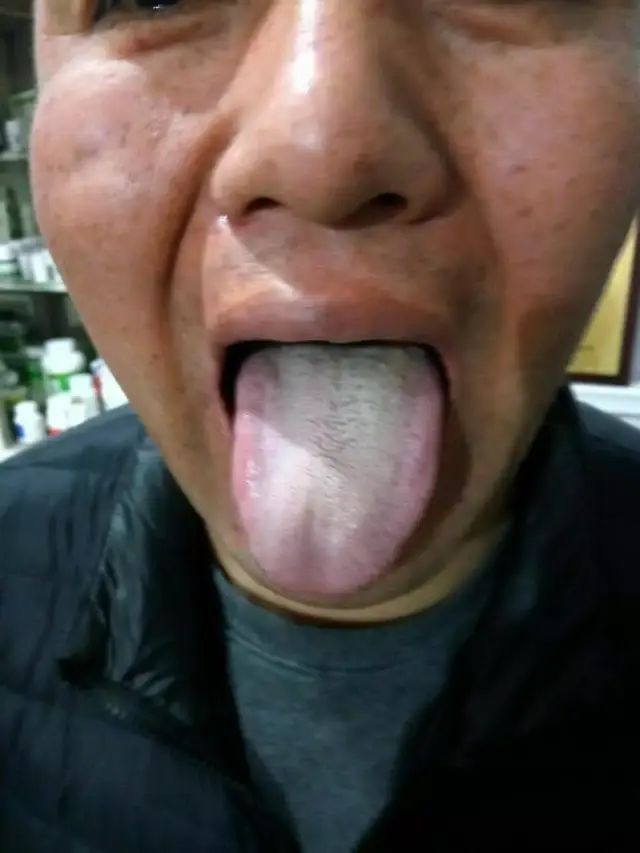
Next, let’s look at the tongue coating.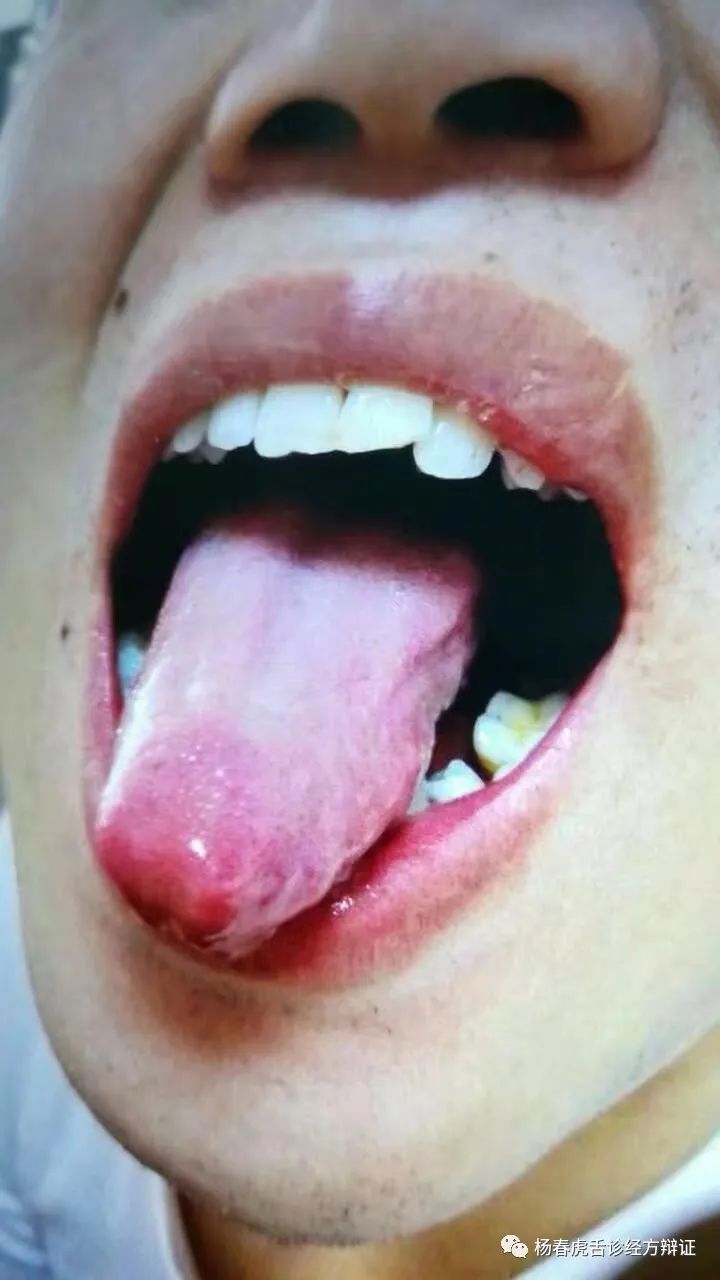
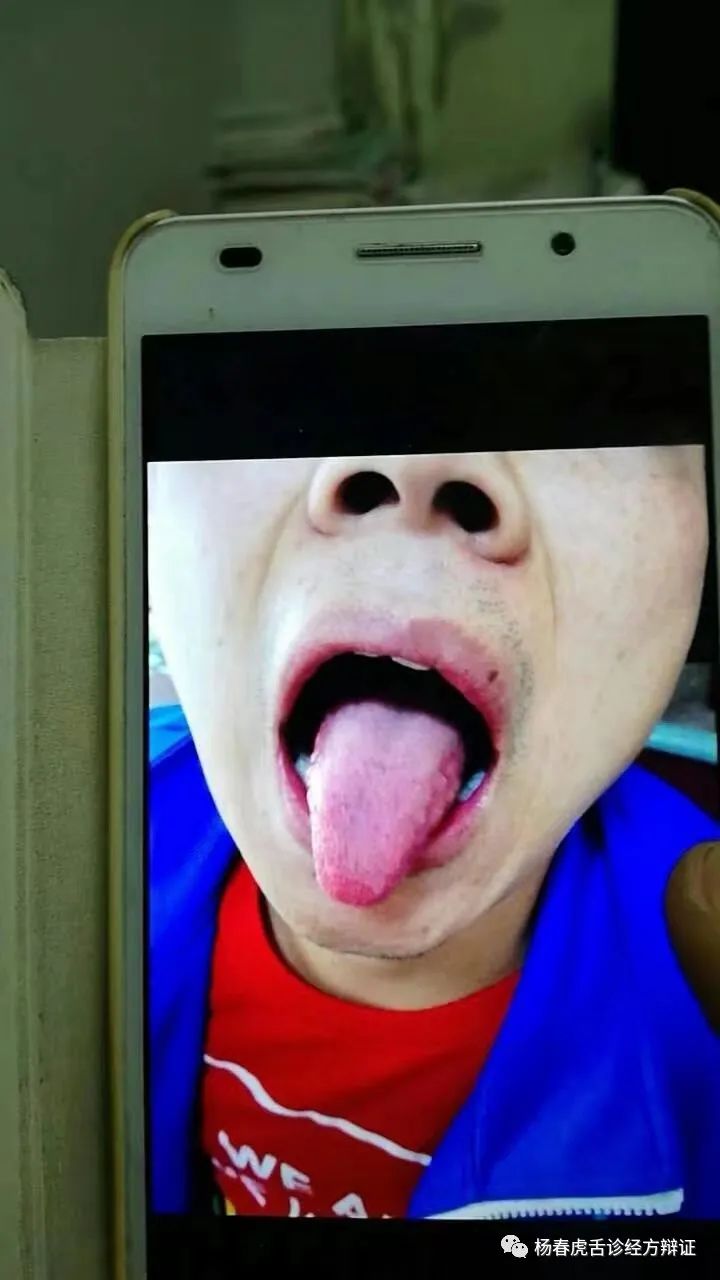 Let’s study the “Shang Han Lun”.
Let’s study the “Shang Han Lun”.
Ban Xia Xie Xin Tang (Pinellia Decoction) states: “For vomiting and rumbling in the intestines, with a feeling of fullness in the chest, Ban Xia Xie Xin Tang is the main treatment.”“Shang Han Lun” states: “If there is a cold for five or six days, with vomiting and fever… but fullness without pain, this is a feeling of fullness; Chai Hu should not be used, and Ban Xia Xie Xin Tang is appropriate.” (149) These passages clearly indicate that Ban Xia Xie Xin Tang can treat gastrointestinal diseases.Upper vomiting, middle fullness, lower rumbling indicates that the disease is throughout the gastrointestinal tract.Vomiting is the main feature of this syndrome, often patients have no appetite for food, or have nausea, or even vomit immediately upon eating, or feel bloated in the upper abdomen shortly after eating, or have reflux of digestive juices.This inability to eat leads to upper reflux.The so-called fullness is characterized by discomfort in the upper abdomen, but upon pressing, it is not hard and full like a stone, nor is it full like a tile; rather, it is soft.Currently, many upper gastrointestinal inflammations can present as “fullness in the chest.”Rumbling often accompanies an increase in bowel movements or unformed stools.Here, the key points are six words: upper vomiting, middle fullness, lower smoothness.Use Huang Lian (Coptis) and Huang Qin (Scutellaria) for indications of middle fullness and lower diarrhea, or thick yellow tongue coating with red tongue body, canker sores, and dry mouth.Fullness is a blockage; pungent opens and bitter descends, so fullness can be dispersed.Therefore, this yellow greasy tongue coating and diarrhea with a feeling of fullness in the chest should use Huang Lian (Coptis) and Huang Qin (Scutellaria).In the “Shang Han Lun,” the use of medications is very particular.There are specific syndromes for specific formulas.If there are no such indications, simply having a yellow-white tongue coating does not require Huang Lian (Coptis) or Huang Qin (Scutellaria).In recent years, there have been many reports on the use of Ban Xia Xie Xin Tang for treating gastritis, with an overall effective rate of over 90%, indicating that Ban Xia Xie Xin Tang has effects against Helicobacter pylori infection, participates in immune regulation, protects gastric mucosal barrier function, and stops bleeding.In my experience, using the original formula of Ban Xia Xie Xin Tang for chronic gastritis is effective.If the patient has a long-standing condition that has not healed, with a dull complexion and pale red tongue, 5 grams of Rou Gui (Cinnamon) can be added.If there is throat pain and significant chest tightness, Shan Zhi (Gardenia) and Lian Qiao (Forsythia) can be added for better results.For bleeding caused by erosive gastritis, Zhi Da Huang (Prepared Rhubarb) can be added.Gastric diseases are common and prevalent among Chinese people, and Ban Xia Xie Xin Tang is also a commonly used formula, a time-tested ancient prescription.Ban Xia Xie Xin Tang’s classic compatibility includes Huang Lian (Coptis) and Huang Qin (Scutellaria) combined with Ban Xia (Pinellia) and Gan Jiang (Dried Ginger), known as the bitter-pungent compatibility method.It treats many gastrointestinal diseases and febrile diseases, often with immediate results.The experience of combining Huang Lian (Coptis) and Huang Qin (Scutellaria) with Ban Xia (Pinellia) and Gan Jiang (Dried Ginger) is the core of Ban Xia Xie Xin Tang.The key points of this disease are:Is there “fullness in the chest”?Is the tongue coating thick and greasy?Are the stools formed or is there diarrhea?To use Ban Xia Xie Xin Tang effectively, there are a few more points to mention.First, this formula is specialized for gastric diseases. Although there are reports of its use for diseases in other systems, they generally accompany upper gastrointestinal symptoms.Second, this syndrome is often seen in relatively healthy young and middle-aged individuals, whose lips and tongues are red, often accompanied by sleep disturbances and a tendency towards diarrhea.The tongue coating is often yellow greasy, but the pulse does not have obvious characteristics.Third, the pathogenesis of this syndrome is a mixture of cold and heat, with a deficiency of the middle leading to heat accumulation.Ban Xia Xie Xin Tang is one of the most representative formulas that combines cold and heat, tonifying and purging. As long as there is gastritis, even if the tongue is red, it does not avoid using ginger and pinellia; even if the tongue is pale, it does not avoid using Huang Qin (Scutellaria) and Huang Lian (Coptis).Fourth, in the formula, Ren Shen (Ginseng) can be replaced with Dang Shen (Codonopsis).Compared to Wen Dan Tang (Warm the Gallbladder Decoction), Ban Xia Xie Xin Tang has more prominent mental symptoms, such as insomnia, irritability, palpitations, easy fright, and vivid dreams, while the former focuses on gastrointestinal symptoms.Ban Xia Xie Xin Tang is also different from Xiang Sha Yang Wei Wan (Aromatic Sand Nourishing the Stomach Pill).The latter is mainly used for individuals with a yellow complexion and indigestion, while Ban Xia Xie Xin Tang is often used for those with infections in the stomach, so Ke Yun Bo said, “For those who vomit with heat, it is not suitable for Xiang Sha or Ju Ban; taking this formula will be like a feast” (“Shang Han Fu Yi: General Discussion on Tai Yang Formulas”). The presence of heat is a characteristic.Regarding the classic prescription of Huang Lian (Coptis) and Gan Jiang (Dried Ginger) combined with Fu Zi (Aconite), there is also a formula called Wu Mei Wan (Mume Pill).Understanding Wu Mei Wan helps us better handle some difficult diseases encountered in clinical practice.
Wu Mei Wan includes Wu Mei (Mume), Gan Jiang (Dried Ginger), Xi Xin (Asarum), Dang Gui (Angelica), Gui Zhi (Cinnamon Twig), Ren Shen (Ginseng), Huang Lian (Coptis), Huang Bai (Phellodendron), and Chuan Jiao (Sichuan Pepper).Wu Mei Wan’s tongue coating is white and slippery, and the tongue is red. Zhang Zhongjing discusses Wu Mei Wan as a cold in the organs; we now use it mainly for Yang depression syndrome.
Yang depression syndrome is not the same as Yang deficiency syndrome. Yang deficiency syndrome means that Yang Qi is low and cannot emerge from the body, while Yang depression means that Yang Qi cannot be well distributed, leading to cold limbs, while certain areas may indeed be heat syndromes.
In clinical practice, many patients experience diarrhea, cold hands and feet, lower limb edema, while the mouth has canker sores, headaches, chest heat, and dry mouth.This forms a typical pattern of upper heat and lower cold, where Yang Qi cannot be distributed, leading to poor transformation, resulting in a white-yellow tongue coating.Therefore, treatment must warm and open the blood vessels using Gui Zhi (Cinnamon Twig), Ren Shen (Ginseng), and Dang Gui (Angelica), and then warm Yang using Xi Xin (Asarum) and Gan Jiang (Dried Ginger). Xi Xin is a versatile herb.
Dispersing cold is best achieved by mobilizing the essence and Qi in the kidneys, which is very powerful, while clearing heat uses Huang Lian (Coptis) and Huang Bai (Phellodendron).Currently, diseases such as ascariasis, diarrhea, and gynecological yellow discharge combined with Yang deficiency are complex diseases that can generally be treated with Wu Mei Wan.Understanding Wu Mei Wan helps us understand the significance of a red tongue with a white coating.Similar to Wu Mei Tang (Mume Decoction), there is also Huang Lian Tang (Coptis Decoction).This indicates cold in the middle and heat above.Wu Mei Tang indicates cold in both the middle and lower jiao.It is essential to distinguish between the two.The further development of cold-dampness is damp-heat, where phlegm-dampness transforms into heat.
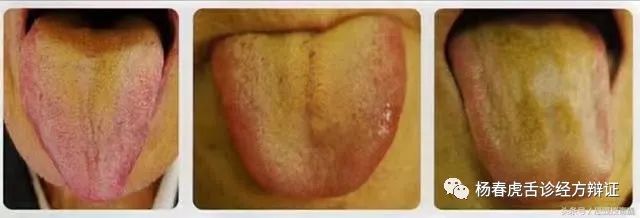 First, the chicken heart tongue with red edges indicates liver Qi stagnation transforming into fire. Dan Zhi Xiao Yao Wan (Gardenia and Bupleurum Pill) is the second. The third, with red edges and thick white coating in the middle, also indicates liver-spleen disharmony. The tender edges indicate liver Yin deficiency, treated with Tian Hua Fen (Trichosanthes Root) and Chai Hu Gui Zhi Gan Jiang Tang (Bupleurum, Cinnamon, and Dried Ginger Decoction).
First, the chicken heart tongue with red edges indicates liver Qi stagnation transforming into fire. Dan Zhi Xiao Yao Wan (Gardenia and Bupleurum Pill) is the second. The third, with red edges and thick white coating in the middle, also indicates liver-spleen disharmony. The tender edges indicate liver Yin deficiency, treated with Tian Hua Fen (Trichosanthes Root) and Chai Hu Gui Zhi Gan Jiang Tang (Bupleurum, Cinnamon, and Dried Ginger Decoction).
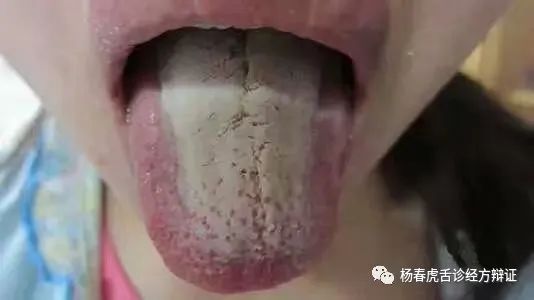 The red edges of the tongue with thick yellow greasy coating indicate a typical Huang Lian tongue prescription: Qin Lian Wen Dan Tang (Bupleurum and Coptis Warm the Gallbladder Decoction).
The red edges of the tongue with thick yellow greasy coating indicate a typical Huang Lian tongue prescription: Qin Lian Wen Dan Tang (Bupleurum and Coptis Warm the Gallbladder Decoction).
Observe the tongue coating below.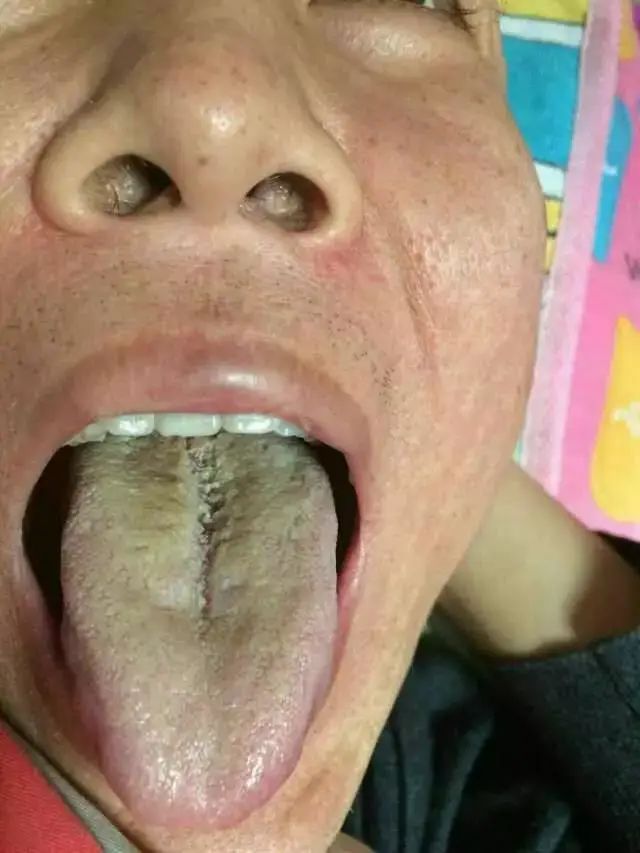
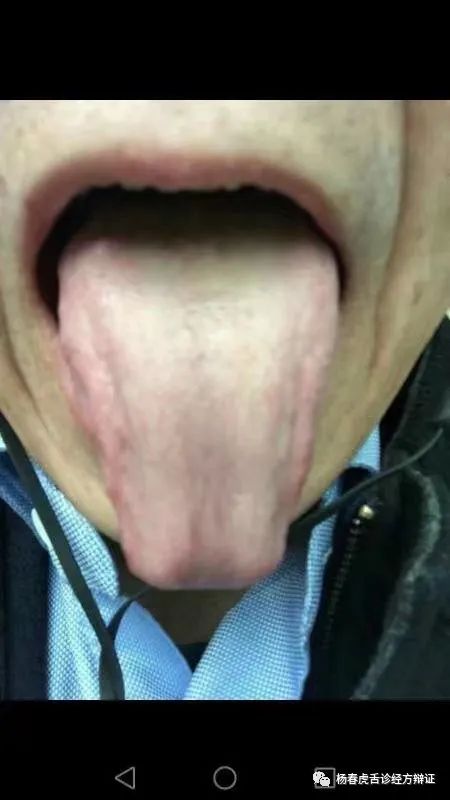 This tongue coating appears dirty, sticky, and greasy. It is not just ordinary damp-heat but phlegm-dampness. This type of tongue coating is essentially treated with Wen Dan Tang (Warm the Gallbladder Decoction). The formula includes Zhu Ru (Bamboo Shavings), Zhi Ke (Bitter Orange), Ban Xia (Pinellia), Chen Pi (Dried Tangerine Peel), Fu Ling (Poria), and Sheng Jiang (Fresh Ginger). The most important herb in this formula is Sheng Jiang (Fresh Ginger), with a basic dosage of 12 grams. Why is it the heaviest? Sheng Jiang disperses moisture and oil. Regardless of whether the tongue coating is thick or white, Sheng Jiang must be used.
This tongue coating appears dirty, sticky, and greasy. It is not just ordinary damp-heat but phlegm-dampness. This type of tongue coating is essentially treated with Wen Dan Tang (Warm the Gallbladder Decoction). The formula includes Zhu Ru (Bamboo Shavings), Zhi Ke (Bitter Orange), Ban Xia (Pinellia), Chen Pi (Dried Tangerine Peel), Fu Ling (Poria), and Sheng Jiang (Fresh Ginger). The most important herb in this formula is Sheng Jiang (Fresh Ginger), with a basic dosage of 12 grams. Why is it the heaviest? Sheng Jiang disperses moisture and oil. Regardless of whether the tongue coating is thick or white, Sheng Jiang must be used.
This oil represents the dampness and stickiness. Many overweight individuals have bodies that particularly produce oil, with oily hair and skin, indicating heavy phlegm-dampness.
People with heavy phlegm-dampness have stools that are oily and sticky, which do not flush easily in the toilet.
In the “Shang Han Lun,” it states: “For phlegm and fluid diseases, one should use warming herbs to harmonize them.” Hence, the metaphor “When the light is clear, the shadows disperse.”
Thus, Sheng Jiang plays an extremely important role in Wen Dan Tang. If the tongue body is red and the coating is thick and yellow, with obvious heat symptoms, Huang Qin (Scutellaria) and Huang Lian (Coptis) can be added (as seen in the second image). If it appears yellow greasy, Da Huang (Rhubarb) can be added to eliminate waste.
At the same time, adding Shen Qu (Malt), Mai Ya (Barley Sprout), and Lai Fu Zi (Radish Seed) or pairing with Bao He Wan (Preserve Harmony Pill) will yield significant effects. Regarding greasy coatings, they need to be transformed. What is dampness? This is a concept in TCM that Western medicine does not have a method to check for dampness, nor does it have a treatment for dampness. TCM uses aromatic herbs to transform dampness, such as Bai Dou Kou (White Cardamom), Sha Ren (Amomum), and Huo Xiang (Agastache). In severe cases, add Cao Guo (Tsaoko Fruit). For thick and greasy coatings,
|
if the tongue body is rough with a yellow greasy or black dry coating, phlegm, Qi stagnation, and blood stasis must be treated with Chuan Shan Jia (Pangolin) and Liu Xing Zi (Coriander Seed) to transform blood stasis and open the channels. The tongue coating will transform immediately. For any Yang deficiency or Qi deficiency syndrome, if a yellow greasy tongue coating is seen, blindly using Hou Po (Magnolia Bark), Xiang Fu (Cyperus), or Ban Xia (Pinellia) will inevitably lead to a downward descent of Qi. The heart is like hanging in the chest; medication must be used with caution. Cao Guo (Tsaoko Fruit) and fried Bing Lang (Areca Nut) must be mentioned in a famous formula for treating epidemics: Da Yuan Yin (Great Source Decoction). Da Yuan Yin consists of Bing Lang (Areca Nut), Cao Guo (Tsaoko Fruit), Hou Po (Magnolia Bark), Shao Yao (Peony), Zhi Mu (Anemarrhena), Huang Qin (Scutellaria), and Gan Cao (Licorice). It is used to treat epidemics or malaria, with symptoms of aversion to cold, strong fever, irregular onset, chest tightness, nausea, headache, irritability, wiry and rapid pulse, deep red tongue edges, and greasy or thick white coating. |
To eliminate spleen and stomach damp-heat, the first step is Wen Dan Tang (Warm the Gallbladder Decoction) with Chao Pu Huang (Acorus) and Yu Jin (Curcuma). The second step is Wen Dan Tang with Yin Chen (Artemisia) and Ze Xie (Alisma). The third step is Wen Dan Tang with Long Gu (Dragon Bone), Mu Li (Oyster Shell), and Hai Ge Ke (Sea Cucumber). In the process of treating phlegm-dampness, one can also use blood-activating and damp-dispelling herbs such as Dan Shen (Salvia), Ze Lan (Lycopus), and Lai Fu Zi (Radish Seed) to promote blood circulation and dispel dampness.
Wen Dan Tang includes Ban Xia (Pinellia), Zhi Ke (Bitter Orange), Fu Ling (Poria), Zhu Ru (Bamboo Shavings), Chen Pi (Dried Tangerine Peel), Sheng Jiang (Fresh Ginger), and Gan Cao (Licorice). Among these herbs, Sheng Jiang is used in the heaviest dosage. This formula can regulate the digestive system, immune system, and has antibacterial, toxic suppression, anti-tumor, and anti-inflammatory effects. Fu Ling (Poria) has anti-cancer properties and can suppress sarcomas, killing Leptospira and suppressing tuberculosis bacteria. Chen Pi (Dried Tangerine Peel) has a vitamin P-like effect, reducing capillary permeability, preventing microvascular bleeding, and stopping subcutaneous bleeding caused by snake venom in mice. Zhi Ke (Bitter Orange) also has strong anti-inflammatory properties and can reduce swelling and pus discharge.
Currently, almost all cancers are related to phlegm-dampness.This phlegm-dampness can also be understood as a virus in Western medicine.Once a person has phlegm-dampness, Qi stagnation occurs, blood flow becomes obstructed, and blood stasis arises. When the transportation of the body is blocked, numerous diseases arise.Generally, when seeing a patient with a yellow-white greasy tongue coating,Wen Dan Tang is used with modifications.Thus, Wen Dan Tang is the remedy for our modern diseases.
In clinical practice, we observe one type of tongue coating:
Liver Qi stagnation with phlegm-dampness.
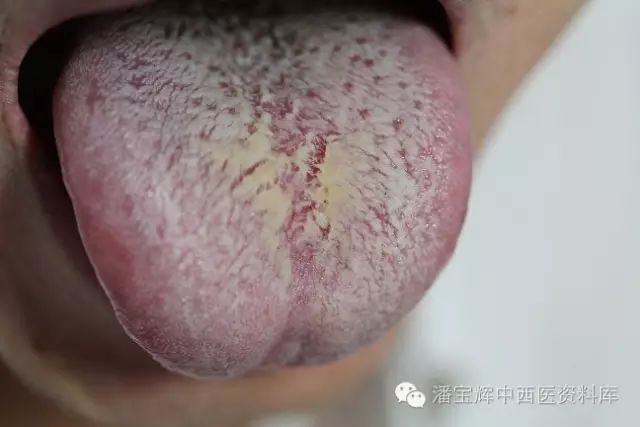
This gradually leans towards a heavier stasis, with a protruding tongue, thick, sticky, and turbid coating. The coating is rough, indicating a solid syndrome.
The tongue coating appears woven, indicating significant stagnation. The treatment approach is to use Wen Dan Tang to transform phlegm-dampness.
Xue Fu Zhu Yu Tang (Blood Mansion Dispersing Stasis Decoction) enhances Qi activation and disperses stasis, adding Cao Guo (Tsaoko Fruit), Bing Lang (Areca Nut), and Zao Jiao (Soapberry) to strengthen the power of phlegm-dampness transformation. The tongue tip also has issues, so Dan Shen (Salvia) should be added to open the heart Qi. If the tongue body is red, Huang Lian (Coptis) can be added.
Spleen deficiency with phlegm stagnation.
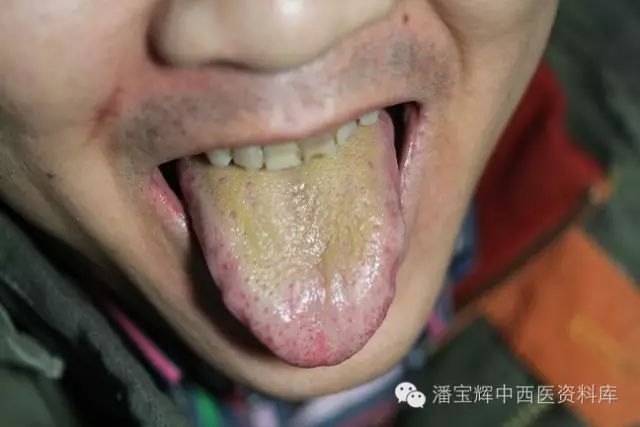
This indicates a clear fire transformation, with a significantly red tongue tip and a very obvious yellow coating, with a central depression and a sticky coating. At this time, the heat is due to the deficiency of the earth, leading to an inability to transport. Similarly, do not use heat-clearing medications; dampness stagnates and accumulates in the middle jiao, causing local Qi stagnation and transforming into fire, which is essentially a deficiency fire. If heat-clearing medications are used, it will immediately harm the middle Yang. Once the middle Yang is harmed, the middle jiao’s transport becomes weaker, and the entire Qi mechanism will be even more obstructed, so do not easily use heat-clearing medications.
In such cases, the “Eye Disease Classic” states: A white tongue coating indicates slight cold; a yellow tongue coating indicates great cold and chronic cold. Why? Because the more severe the stasis, the more deficient it becomes. The so-called cold corresponds to the weakness of the middle Yang; the weaker the Yang Qi, the more internal cold accumulates, leading to heavier stagnant fire, so it is essential to strengthen the transport.
Treatment approach: Bai Zhu (Atractylodes) and Cang Zhu (Atractylodes) strengthen the spleen and transform damp-heat. If the tongue coating is yellow, Pu Gong Ying (Dandelion) or Zhu Ru (Bamboo Shavings) can be added without harming the spleen and stomach. Gan Jiang (Dried Ginger), Shan Yao (Chinese Yam), Bai Dou Kou (White Cardamom), and Bian Dou (Hyacinth Bean) can be used to strengthen the spleen and stomach and replenish middle Qi. If the tongue has red spots, Dan Pi (Moutan Root) and Dan Shen (Salvia) can cool the blood and activate blood circulation. If there are tooth marks, it indicates liver-spleen disharmony, treated with Bo He (Peppermint), Mai Ya (Barley Sprout), and Chai Hu (Bupleurum) to soothe liver Qi. If the tongue coating is thick, black and white herbs can be added to transform phlegm and strengthen the spleen against cold phlegm-dampness.
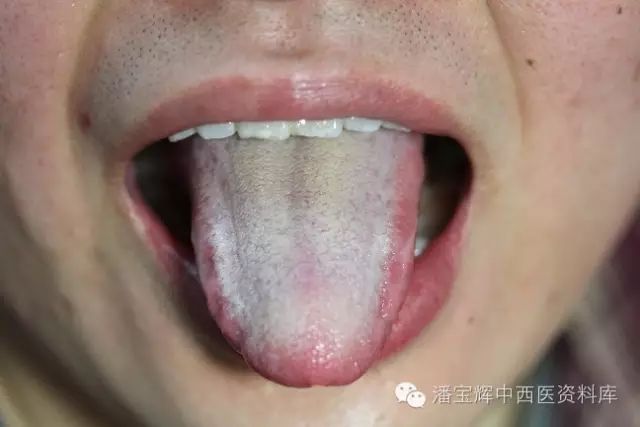
This tongue has become significantly red, appearing to have a peeled coating. This clearly indicates hepatitis, likely indicating a large three Yang condition. The tongue has a white coating, indicating spleen and stomach cold deficiency.
The tongue coating is not enlarged but small, indicating liver Yin deficiency. The treatment approach is to use Chai Hu Gui Zhi Gan Jiang Tang (Bupleurum, Cinnamon, and Dried Ginger Decoction) with Nu Zhen Zi (Ligustrum) and Shan Zhu Yu (Cornus) to nourish the liver, Bai Shao (White Peony) and Dang Gui (Angelica) to soften the liver, and Huang Qin (Scutellaria) to clear liver and gallbladder fire, using Che Qian Cao (Plantago) to treat elevated GPT levels. The prescription for treating hepatitis in the “Shang Han Lun” is Chai Hu Gui Zhi Gan Jiang Tang.
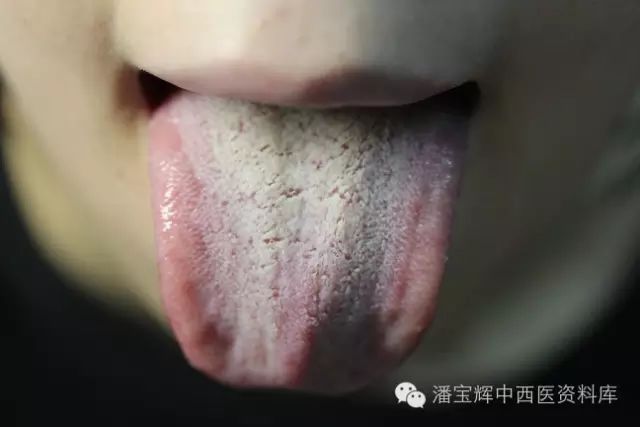
This also indicates significant stagnation in the middle jiao, with a sticky coating. When observing such a sticky coating, at least Bai Dou Kou (White Cardamom), Zhu Ru (Bamboo Shavings), Cang Zhu (Atractylodes), and Zao Jiao (Soapberry) should be used to dissolve the phlegm-turbidity, rather than simply using damp-dispelling medications, as damp-dispelling medications cannot dissolve phlegm-turbidity. The red edges of the tongue indicate liver Yin deficiency, so the treatment approach is to first use Wen Dan Tang to transform phlegm-dampness. After the phlegm-dampness is transformed, then nourish the liver. If the tongue body is pale, Huang Lian (Coptis) and Huang Qin (Scutellaria) should be used cautiously, and heat-clearing and damp-transforming medications such as Hua Shi (Talc) can be used.
Qi stagnation with phlegm-dampness.

The tongue coating is relatively moist, indicating severe dampness, and the tongue coating is relatively large, which is referred to as Qi stagnation with phlegm-dampness. In this case, use less Huang Qi (Astragalus) to tonify Qi and diurese dampness, and add Zhi Ke (Bitter Orange), Chen Pi (Dried Tangerine Peel), and Gan Jiang (Dried Ginger) to warm Yang. Er Chen Tang (Two Aged Decoction) can be added with Dou Kou (Cardamom) and Mi Ren (Rice) to transform dampness and also activate blood circulation to resolve stasis.
Above is the principle of nourishing Yin without generating dampness and transforming dampness without harming Yin. The focus is on promoting lung Qi and transforming the three jiao. The tongue coating entering the large intestine will lead to intestinal waste, causing constipation. Case study: Male, 51 years old, with long-term constipation, sometimes frequent, or not passing for several days, or having several bowel movements in one day but in small amounts and very uncomfortable. He drinks aloe to relieve constipation 1-2 times. In the past year, the symptoms have worsened, with daily bowel movements of 8-9 times, wanting to defecate all day long but unable to do so completely, with anal distension. He has previously taken Bu Zhong Yi Qi Tang (Tonify the Middle and Augment the Qi Decoction) and Bai Shao Tang (White Peony Decoction) with no effect. This year, he has had slight abdominal pain. The tongue is enlarged with a yellow greasy coating at the root. Everyone, take a close look at this tongue coating; the front half has no coating, is enlarged, with red spots, and the root is thick and greasy, covering the areas of the uterus, ovaries, bladder, rectum, pelvic cavity, and male reproductive organs. A thick and greasy root indicates phlegm-dampness. If it turns yellow, it indicates phlegm-dampness transforming into heat, which can also be referred to as damp-heat. At this time, we can integrate TCM theory, as TCM emphasizes etiology and pathogenesis, which can help us accurately diagnose.
Everyone, take a close look at this tongue coating; the front half has no coating, is enlarged, with red spots, and the root is thick and greasy, covering the areas of the uterus, ovaries, bladder, rectum, pelvic cavity, and male reproductive organs. A thick and greasy root indicates phlegm-dampness. If it turns yellow, it indicates phlegm-dampness transforming into heat, which can also be referred to as damp-heat. At this time, we can integrate TCM theory, as TCM emphasizes etiology and pathogenesis, which can help us accurately diagnose.
First, heavy dampness is present, with stickiness; a thick root coating also indicates retained stool. The thicker the coating, the more stool is present. Most of these patients experience constipation or have gynecological or male diseases.
A thick and greasy root indicates frequent bowel movements. It should have been constipation, but why is it increasing? We know that only when the stool stimulates the anal dentate line can the urge to defecate occur. Therefore, patients with frequent bowel movements are unable to finish their bowel movements. With retained stool, after a few hours or after eating, gastrointestinal peristalsis accelerates, and then the stool stimulates the dentate line, leading to the urge to defecate, which is caused by the inability to completely expel retained stool.
Regardless of whether it is constipation or frequent bowel movements, as long as such a tongue coating is observed, it is necessary to promote smooth bowel movements. In Hubei, Yu invented a formula called Tong Chang (Four Herbs for Smooth Bowel Movements), consisting of Huo Ma Ren (Hemp Seed), Zhu Jiao (Pig’s Hoof), Ai Ye (Mugwort), and Ku Shen (Sophora Root), which has the characteristics of moistening, promoting, and clearing.
In China, the famous classical formula master Liu Fangbai invented a formula called Xing Zhi Tong Chang Tang (Activate Stagnation and Smooth Bowel Decoction). It consists of Gan Jiang (Dried Ginger), Huang Lian (Coptis), Wu Mei (Mume), Qing Pi (Green Tangerine Peel), Mu Xiang (Aucklandia), Jian Qu (Fermented Wheat), Zhi Ke (Bitter Orange), Bing Lang (Areca Nut), Sheng Bai Zhu (Fresh Atractylodes), and Lai Fu Zi (Radish Seed). This formula is specifically for the above tongue coating. Huang Lian (Coptis) is specifically for treating bowel movements, paired with Shu Di (Rehmannia), which can also guide fire into the kidneys. This herb is used less for tonifying the spleen and more for clearing the intestines and clearing fire. For a thick tongue coating, Gan Jiang (Dried Ginger) must be used.
To promote bowel movements, Qi must be regulated using Mu Xiang (Aucklandia), Zhi Ke (Bitter Orange), and Lai Fu Zi (Radish Seed). Sheng Bai Zhu (Fresh Atractylodes) is also heavily used to tonify the spleen and regulate Qi. Bing Lang (Areca Nut), Qing Pi (Green Tangerine Peel), and Wu Mei (Mume) are used to regulate Qi and transform accumulated Qi. It is particularly important to note that Sheng Bai Zhu (Fresh Atractylodes) is specifically for treating dead muscle, gynecological inflammation, cervical erosion, and intestinal polyps, which can all be understood as dead muscle. Especially the growth of the endometrium, which is not expelled cleanly, can be treated with Bai Zhu to promote the growth of new muscle, and it must be used heavily.
In my experience, for any thick and greasy tongue root, using Zhi Da Huang (Prepared Rhubarb), Dong Gua Zi (Winter Melon Seed), and Tao Ren (Peach Kernel) is somewhat similar to the meaning of Da Huang Mu Dan Tang (Rhubarb and Peony Decoction). Of course, if the inflammation is severe, you can add Guan Zhong (Cynanchum) and Bai Hua She She Cao (Hedyotis) and other herbs. However, doctors who do not observe the tongue will see frequent bowel movements and only stop diarrhea, leading to many cases of colitis that do not heal, and the more they stop diarrhea, the more severe it becomes. In gynecology, seeing this tongue, various inflammations naturally increase, and for men, impotence and premature ejaculation, if there are tooth marks, will lead to incomplete urination. After urination, straining will also lead to discharge, indicating issues with the anterior segment. If the tongue root is thick and protruding, it indicates hyperplasia, leading to difficulties in bowel movements, and bifurcated urination may also occur. Premature ejaculation and impotence are certainly present, as heat interferes with the essence, which is a matter of minutes.
Everyone should remember, for any thick and greasy tongue root, in individuals with good constitution, the three herbs Mi Ren (Rice), Dong Gua Zi (Winter Melon Seed), and Da Huang (Rhubarb) should be used. Mi Ren should be fried, as raw does not have the effect of eliminating damp-heat; if it is to eliminate damp-heat, it is best to fry it. For frequent bowel movements, use Da Huang 3-6 grams; for constipation, use raw Da Huang 10-15 grams.
This lesson is concluded.
We have finished discussing yellow greasy coatings and will learn about gray and black coatings in the next session.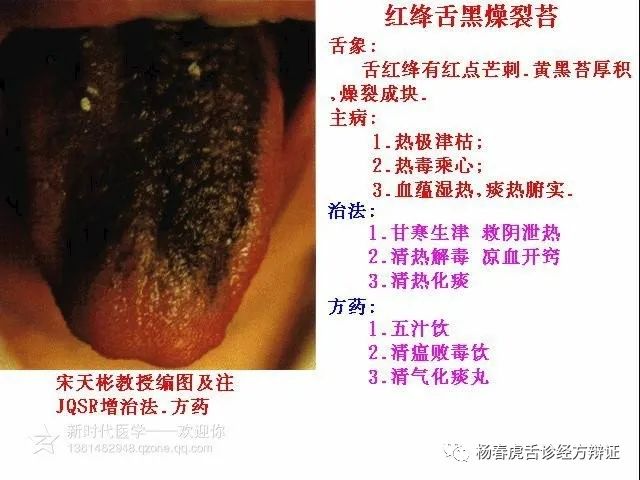
Yellow-gray coating indicates the gradual onset of heat, while black coating indicates extreme heat (extreme heat can transform into cold).
In clinical practice, black coatings are not commonly seen, so when encountering gray-black coatings, it is essential to inquire in detail about how long this gray-black coating has been present, whether black or dark-colored foods or beverages have been consumed, etc., to rule out staining of the coating.
Gray-black coatings, being the extreme of heat, will present with symptoms of heat or heat damaging fluids, such as thirst and constipation, as internal fire slowly burns, turning the tongue coating into a black color. Through this manifestation, many symptomatic expressions can be inferred.
When encountering true black coatings, they are generally indicative of very serious diseases.
Treatment for black coatings is relatively simple; remember this phrase: black coatings also have another name, called “Da Huang Tong” (Rhubarb Tongue).
This means that this black coating is suitable for patients who require long-term use of Da Huang (Rhubarb) for treatment. Why choose Da Huang?
TCM therapy is referred to as “removing the fuel from the fire.”
Dosage: Da Huang 10 grams; for severe constipation, it can be increased to 15-30 grams (it can also be combined with Mang Xiao (Glauber’s Salt)); for mild constipation or soft stools that are prone to diarrhea, a small amount can be used initially, gradually adjusting the dosage as needed. Prepared Da Huang can also be used.
Da Huang 10 grams, Sheng Di (Rehmannia) 30 grams, Xuan Shen (Scrophularia) 30 grams, Mai Dong (Ophiopogon) 30 grams as the main formula with modifications.
Few coatings, gray-black coatings are also dry, indicating Yin deficiency. The formula for increasing fluids is a good remedy for nourishing Yin. This formula can also be supplemented with Jie Geng (Platycodon) and Xing Ren (Apricot Kernel) to promote lung function and descending.

